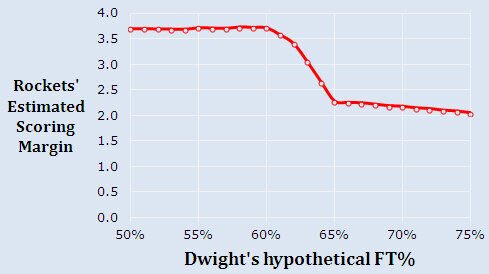Popular wisdom says that if Dwight Howard improves his free-throw shooting, then the Rockets will win more games. The reasonable-sounding argument goes like this: If Dwight could only make 75% of his free throws – the League average – then he would make 8.7 (rather than 6.1) of his 11.6 attempts per game, so the Rockets would score 2.6 more points per game, which would increase their expected number of wins by 6 or 7 games (according to the Pythagorean expectation), which could be the difference between a sixth seed and a third seed in the playoffs, which would be huge.
But that assumes that Dwight would continue to have the same number of free-throw attempts. In reality, if Dwight managed to consistently shoot 75% from the line, Hack-a-Dwight would no longer be a viable strategy for opponents and they would no longer find it so attractive to tackle Dwight during every post move, so his FT attempts would probably drop by more than half. And that makes all the difference because free throw attempts are more valuable than they at first seem.
With the exception of wide open lay ups and wide open corner threes, free throws are the most efficient play in basketball. Even though he’s one of the worst free-throw shooters in NBA history, a Dwight Howard trip to the line tends to be more efficient than an average Rocket offensive possession. So far this season, the Rockets are scoring 1.05 points per possession, and 1.06 points when Dwight goes to the line, and that’s not even considering And-1 opportunities and the potential for offensive rebounds. Plus, the more Dwight gets sent to the line, the more effective the Rockets will be on defense since there will be fewer transition opportunities for the other team. And the more Dwight gets fouled, the more likely the opponent’s best players are to get themselves in foul trouble.
Here’s the simplest way of putting it. Improving Dwight’s free-throw percentage would have two conflicting effects: (1) on the positive side, it would make Dwight’s trips to the line more efficient, (2) on the negative side, it would reduce his total number of trips to the line (and thereby reduce overall efficiency and reduce the likelihood of getting the other team in foul trouble). To estimate which effect outweighs the other, we have to make some assumptions. Here are the main assumptions I made:
- Dwight’s FT attempts would gradually decline as his FT% increased, with the steepest decline happening at a FT% around 60-65% (because that’s roughly when teams would not longer find Hack-A-Dwight worthwhile). If his FT% improved all the way to 75%, his free-throw attempts would drop from 11.6 to 4.6 per game.
- On an ordinary possession, the Rockets are expected to score 1.05 points and give up 1.013 points to their opponent. (source)
- After a Dwight free throw, the Rockets’ opponents will score at a rate 10% worse than normal since the Rockets have time to set up their defense.
- If a player misses the back end of a free throw, his team has a 14% chance of grabbing the offensive rebound. (source)
- 11% of Dwight’s free throw attempts are And-1 opportunities. (source)
- If Dwight improved his FT% to 75%, Rockets’ opponents would be in foul trouble less often, which means that in about 25% of all possessions, the Rockets would be 5% worse on offense and 5% worse on defense.
Using those assumptions, I made some convoluted calculations to arrive at these estimates:
These estimates should be treated with at least several grains of salt since they rely on so many assumptions, some of which have no basis in the data at all. The important and interesting point is not the precise estimates but rather the idea that improving Dwight’s FT% may paradoxically hurt the team.
I’ll preempt one criticism: No, this does not mean that James Harden should work on missing more free throws. Harden draws fouls without his opponents wanting to or trying to, so he would probably make a fairly constant number of trips to the line regardless of his FT%. Dwight Howard is a different story.
The gist of this quick and dirty analysis is that, all things considered, sending Dwight to the line is more likely to help rather than hurt the Rockets, so improving his FT% could hurt the team if it meant that he would be sent to the line much less often.
(By the way, there’s another, more indirect way that improving his FT% could hurt the Rockets. The time Dwight spends trying to improve his FT% is not being spent improving other aspects of his game which could help the team more.)
——
Somewhat related: Contrary to what has been said, Dwight Howard’s FT% is not and has never been significantly better on the road than at home. But there have been two statistically significant and fairly dramatic drops in his total FT%: the first after his rookie year (presumably when he gained more strength), and the second around the time of his back surgery. The charts below show his FT% by age with 90% confidence intervals.
View this discussion from the forum.





